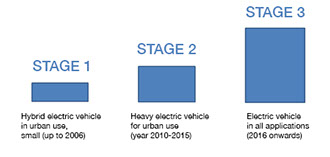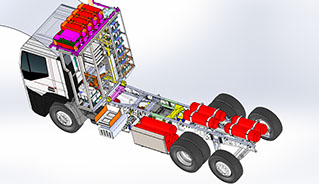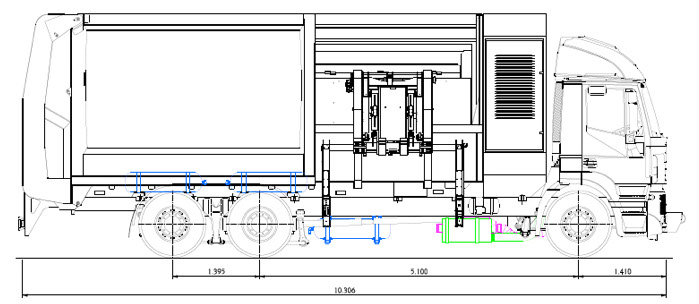

Urban hybrid-electric vehicles for waste collection with ultra-capacitor system
Study, analysis and development of new technologies in hybrid electric motorization for the urban solid waste collection truck
1.- Need for the project. Background >
This project is part of a goal established since 2006 in FCC: The development of a full-electric vehicle for all applications. Achieving this vehicle involves several stages:
In 2006 FCC undertook the first step to achieve this electric vehicle development with the project called "Hybrid Electric KB-I". This diesel engine vehicle was intended for garbage collection only in urban areas of difficult access (dimensions and load capacity reduced). Due to the design and technology available at that time, the battery autonomy was not sufficient to be extrapolated to all vehicles, and the diesel engine was used up to 4 times at the end of each run to recharge the battery.
In 2012, the overall project reaches a second stage, in which FCC decided to achieve fully electric heavy vehicle. At these time begins the development of two prototypes capable of operating in full electric mode for all urban garbage collection cycle.
This vehicle can travel long distances in any city (both urban areas and outside them). This is a range of vehicles from two axles up to four axles with large dimensions and large load capacities.
The main limitation of this vehicle is its high cost, hindering its actual market deployment.
In order to overcome this limitation and get the actual implementation of such vehicles, it is intended to carry out this project, prior phase to achieve the fully electric vehicle, the long-term project of FCC. As described, this vehicle will use a hybrid technology using instead of batteries ultracapacitors.

Stages of development of electric vehicles in FCC
Ultracapacitor hybrid technology
Ultracapacitors are electrochemical devices capable of sustaining a high energy density compared to normal capacitors, presenting a capacitance thousands of times greater than the standard capacity of electrolytic capacitors. Ultracapacitors have a number of advantages:
- Large period of operation
- Ability to handle high current values
- Load value of easy monitoring
- High efficiency
- Large voltage range
- Large temperature range
- Long operating cycles
- Ease of maintenance
For its efficient use of energy, these devices are one of the most important lines of research in the development of means of transportation. Harnessing energy comes mainly from a better energy release during vehicle acceleration.
The use of batteries as the energy storage method has been extensively studied. The most modern ones are lithium ion batteries, characterized by high energy density, long life and for being environmentally friendly. However, these batteries in vehicles require, to achieve the desired capacity, a large size. That along with the problems presented by these batteries as durability and high cost, slows their actual implementation on the market.

2.- General objectives of the project >
The main objective of this project is the design, development and validation of new urban vehicles for the collection of waste including an innovative electrical -hybrid technology using a novel system of ultracapacitors as energy storage elements instead of batteries.
The series hybrid vehicle as presented uses, basically, for its propulsion, an electric engine and an internal combustion engine. The internal combustion engine drives a generator that supplies electricity to an electric motor, which is connected to the wheels; ie the vehicle moves finally supplied with the power of the electric motor, which uses electricity produced by the generator driven by the internal combustion engine.
The present project aims to get a new vehicle with electric and hybrid operation that will reduce energy consumption and emissions of greenhouse gases, and at the same time a more economical solution that allows its actual implementation in the market.
The overall project objectives are:
- The design, development and validation of an innovative platform of electric hybrid heavy-duty vehicle without batteries and with ultracapacitors system for urban service.
- Full Covering of the full range of vehicles needed, both in size and maximum loads.
- Being able to accommodate any type of collector body of municipal solid waste, as well as any other town service (street cleaning equipment, sewer, etc.)
New generation of Hybrid electric vehicle with ultracapacitors 2014/2015 (side loading)

© FCC Servicios Ciudadanos 2015 • Todos los derechos reservados • Prohibida la reproducción total o parcial en cualquier medio excepto con autorización expresa del propietario